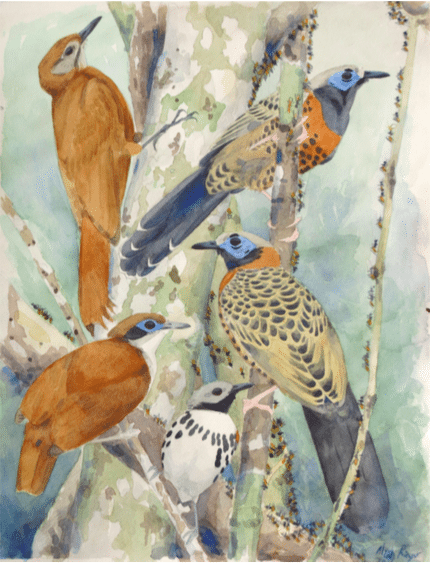
One of the most spectacular scenes one can witness in a tropical rainforest is the swarming of army-ants as they scavenge for prey. As hundreds of thousands of army-ants scour the forest floor in search of food, arthropods and small vertebrates that are normally inconspicuous flee from the path of the encroaching ants.
This mass exodus of biomass, in turn, attracts hundreds of species that associate with ant swarms because of the various types of benefits they accrue, ranging from parasitic wasps that use ant swarms to find suitable hosts; to birds, for which swarms provide easily-obtained prey resources; to butterflies that lay their eggs in the droppings that the birds leave behind.
However, despite their profitability, these swarms are an ephemeral resource because swarming activity is directly related to the reproductive status of the queen. After she has laid the next generation of eggs, the colony enters a statary phase where swarming is greatly reduced, making it challenging to depend on swarms as a stable resource. However, what is particularly fascinating is that some birds have evolved the ability to track and follow multiple swarms simultaneously, allowing them to depend exclusively on the ants for food (Figure 1).

Figure 1: Antswarm following birds at an army-ant swarm of Eciton burchelli in lowland tropical rainforest in Soberanía National Park, Panama. Top left: Plain-brown woodcreeper (Dendrocincla fuliginosa), Top right: Ocellated Antbird (Phaenostictus macleannani), Lower Left: Bicolored Antbird (Gymnopythis bicolor), Lower Center: Spotted Antbird (Hylophylax naevioides). Illustration by Micah Reigner.
In fact, these species regularly check the status of various army ant-colonies to be able to evaluate which colonies will be actively swarming on a daily basis. Nevertheless, these aren’t the only birds that attend swarms – plenty of opportunists are often in attendance as well, which makes for fierce competition at the buffet. A shrewd observer can often hear ant swarms from quite a distance away, as birds jockey for the most profitable position with aggressive posturing and vocalizations.
We know how obligate ant-followers track swarms, but we wanted to understand how ow other birds – the opportunists – were locating them, given that looking for them visually would take a lot of time and energy? One hypothesis in the scientific literature suggests that hangers-on might eavesdrop on the vocalizations of obligate species to find swarms; after all, obligates spend most of their time at swarms and their vocalizations are probably a reliable indicator of swarm presence.
With this in mind, the goal of our study was to understand how the acoustic environment at a swarm attracted other bird species to that swarm. Namely, do birds eavesdrop on each other to glean information about the profitability or competitive environment at a swarm? To address this question, we used acoustic recordings to conduct a playback experiment simulating birds foraging at ant swarms. We simulated bird flocks of different size, species richness, and level of dependence to understand the relative importance of these different types of auditory cues in attracting species to swarms.
Just as the original hypothesis suggested, we found that playbacks of obligate species attracted the most eavesdropping birds to our simulated swarms, as did playbacks simulating bird flocks that were larger and contained more species. We also found evidence of a “social information cascade”, whereby acoustic information was transferred in a sequential way from the most obligate to least obligate species. In simpler terms, the less obligate you are, the later you are to the table. Ultimately, our experiment demonstrates that not all auditory cues are equal and that birds have the remarkable ability to eavesdrop on multiple types of information to decide whether or not to forage at an army-ant swarm.
These findings are described in the article entitled Social information cascades influence the formation of mixed-species foraging aggregations of ant-following birds in the Neotropics, recently published in the journal Animal Behaviour. This work was conducted by Ari E. Martínez from San Francisco State University, Henry S. Pollock from the University of Illinois at Urbana-Champaign, J. Patrick Kelley from the University of New Hampshire, and Corey E. Tarwater from the University of Wyoming.








